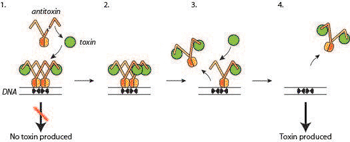Bacteria’s Self-Defense Mechanisms Revealed
By LabMedica International staff writers
Posted on 24 Sep 2012
Danish researchers have gleaned new insights into how bacteria control the amount of toxin in their cells. The new findings can ultimately lead to the development of novel forms of treatment for bacterial infections.Posted on 24 Sep 2012
Many pathogenic bacteria are able to go into a dormant state by making persister cells that are not receptive to conventional antibiotics. This causes serious problems in the treatment of life-threatening disorders such as tuberculosis, where the presence of persister cells often leads to a resurgence of infection following medical treatment.

Image: The toxins normally bind very strongly to the antitoxins and are thus not only inactive, but also prevent the production of more toxin from the information encoded in the bacterial DNA. During the dormant state, however, the antitoxins are degraded, and the toxins released (step 1). The free toxins now bind to unoccupied antitoxins on DNA within the area encoding the toxin-antitoxin couple (step 2). Binding increasing amounts of toxin eventually leads to the release of the molecules from the gene (steps 3 and 4) and finally to new toxin production (Photo courtesy of Ditlev E. Brodersen).
At the molecular level, the formation of persister cells is due to the presence of toxins that are produced by the bacteria themselves, and which enable them to enter the dormant state. During this hibernation period, the bacteria constantly regulate the amount of toxin at exactly the same level and thus maintain the dormant state.
In an article published online August 20, 2012, in the American scientific journal Structure, the researchers from the department of molecular biology and genetics, Aarhus University (Aarhus, Denmark), new findings that reveal the molecular particulars of the regulatory mechanism of toxins.
By isolating and crystallizing the toxin molecules and their molecular companions--the antitoxins--and by subsequently exposing the crystals to strong X-rays, the scientists gained unique insight into how bacteria control the amount of toxin in the cell.
The new findings can eventually lead to the development of completely new forms of treatment of bacterial infections that work at first by blocking toxin function and production, and consequently by using conventional antibiotics to fight the pathogenic bacteria.
Related Links:
Aarhus University














